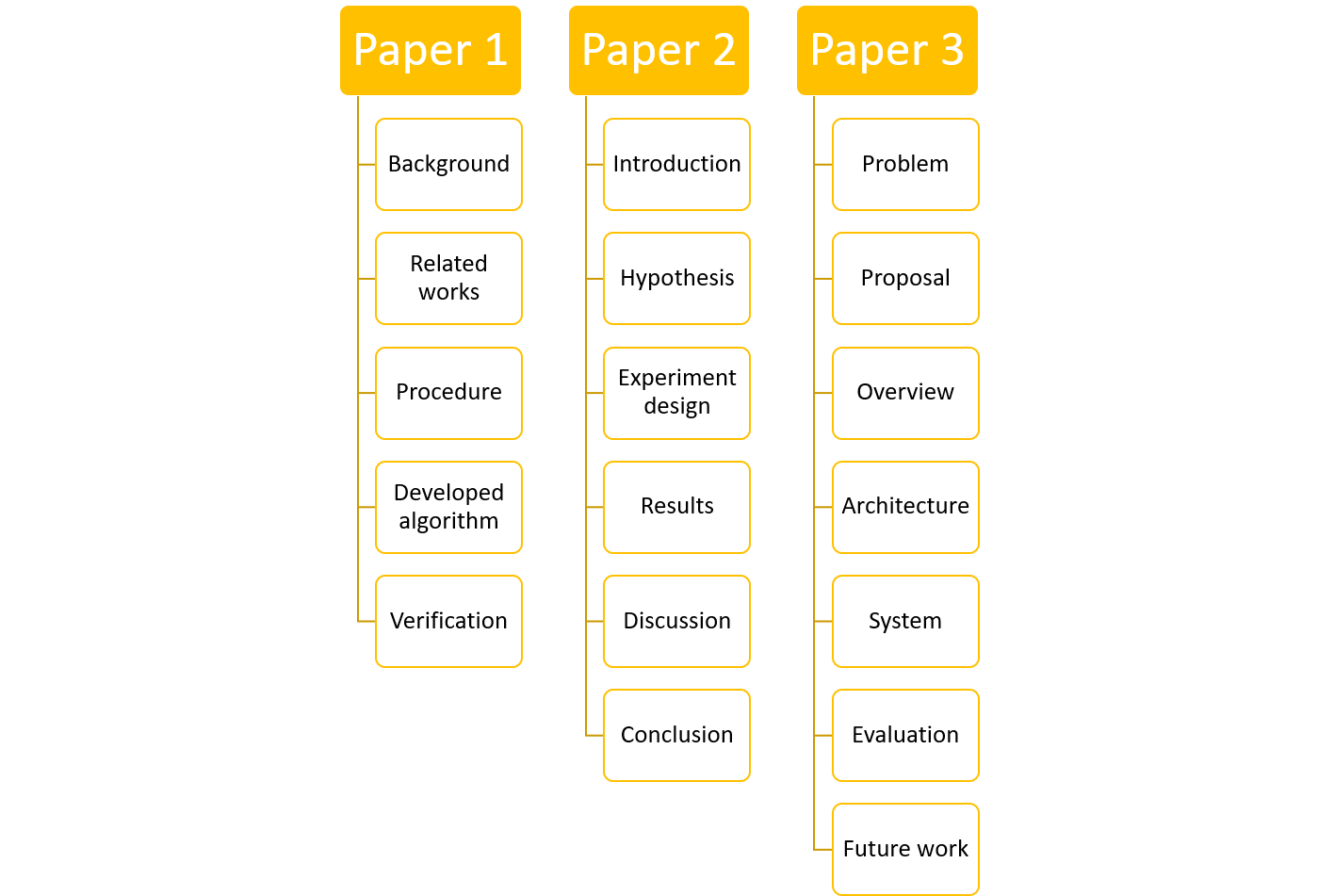By the end of this unit you should:
Work in pairs or small groups. Take it in turns to give a short presentation (1 or 2 minutes) that introduces you, your lab, your research field and your research topic.
Your professor may ask you to present to the whole class, so use this as an opportunity to practise in a low-stress environment.
Reflect on your presentation. Award yourself a grade on each of these three criteria.
| # | Criteria | Very good | Good | Fair | Poor | Very poor |
|---|---|---|---|---|---|---|
| 1 | Content (i.e. enough details) | 5 | 4 | 3 | 2 | 1 |
| 2 | Fluency (i.e. no dead air) | 5 | 4 | 3 | 2 | 1 |
| 3 | Eye contact (i.e. looking at the audience) | 5 | 4 | 3 | 2 | 1 |
Read this section carefully so that you can answer any questions set by your professor.
Each area of computer science and engineering adopts different conventions and guidelines to follow regarding format, layout, organisation and language. The structure of your graduation thesis will depend on the type of thesis.
There are four common types of graduation thesis.
Work in pairs or small groups. Discuss the type of thesis that is most common in your lab. Which type of thesis do you think you will write?State your reasons.
Read this section carefully so that you explain it to a classmate.
The names of the sections used vary greatly between different sub-disciplines in computer science and engineering. They also vary within sub-disciplines. There are however four general types of sections. The first section describes why the research is needed, the second show how the research is done, the third describes what you found or created, and the final section tries to answer the question "so what?". The names of the four generic sections and their key question words are:
These sections are so common that we often use the term IMRD to describe the typical structure of research articles and graduation theses.
Without looking at any notes, explain the four generic sections in a graduation thesis.
Read this list of section and subsection names. When you check research articles and graduation theses produced in your lab or by your supervisor, notice which sections are commonly used. Your mid-term research poster is likely to use some of these section names as headings.
The names are categorized by generic section, but each name may be used as a section or subsection. At the start of a graduation thesis there is an additional section called Abstract and at the end there is a section called References containing all the sources referred to.
Work in pairs or small groups. Discuss the content of your mid-term research posters. Find out which sections both you and your classmate(s) used.
Read.
There are many possible ways to organize a thesis. This is provided as an example to show you one way how sections may be divided into subsections. Do not use this example as your template. The best template for your thesis is a graduation thesis produced by members of your lab who worked on a similiar research project.
| Section | Content and subsections |
|---|---|
| Front matter | Title, author, contact detail, supervisor |
| Abstract | Abstract |
| Introduction | Background |
| Hypothesis or research question | |
| Preview | |
| Method | Data identification |
| Data collection | |
| Statistical analysis | |
| Results | Most important result |
| Second most important result | |
| Third most important result | |
| Summary of results | |
| Discussion | Comparison and contrast, explanations, generalizations 1 |
| Comparison and contrast, explanations, generalizations 2 | |
| Conclusion | Summary of most important results and their related explanations and generalizations |
| Future work | |
| References | Bibliography of cited works |
Each graduation theses (and each research article) has a pattern based on the structure of the sections and subsections. Three possible patterns are show below.

Discover different possible patterns in graduation theses using the Feature Visualizer .
Work in pairs or small groups and discuss what you discovered.
Answer the following question. How do you eat an elephant?

Many students find that is is difficult to write around 2500 words, and so they delay and delay writing as long as possible. Writing a graduation thesis is like eating an elephant. They are both huge tasks. Both tasks are difficult to do. Neither task can be finished quickly. The usual answer to the question: "How do you eat an elephant?" is "One bite at a time". The same can be said for your thesis. "How do you write your thesis?" "One word at a time".
Your very first aim is simple: write just one word, and then your next aim is the second word, and so on. This course aims to help you break 2500 words into smaller managable chunks of writing.
To finish 1% of your thesis, you just need to write 25 words.
Answer the following questions. The answers will help you write the introduction to your thesis.
Try to expand each answer by adding more information. For example, an answer to the third questions could be expanded like this.
Do you know:
If you do not, make sure that you do before your next class.